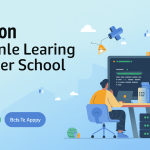
Whether you’re a student exploring tech skills or a professional looking to advance your career, learning SQL (Structured Query Language) is one of the most useful steps you can take today. Codecademy’s “Learn SQL” course is a beginner-friendly, online course designed to help you understand how to manage and analyze data using SQL — all at your own pace.
In this article, we’ll break down everything you need to know about this free SQL course with certificate, including what you’ll learn, who can take it, how to enroll, and how it can help your career.
This course is structured to help complete beginners get comfortable with SQL, even if you have no prior programming experience. Here’s a summary of the key topics covered:
The course also includes 5 real-world projects such as analyzing Hacker News data and managing restaurant information, which help you apply your skills practically.
This course is open to anyone who wants to learn SQL. It’s especially helpful for:
No prior experience or technical background is needed.
You can learn anytime, anywhere. You can pause, revisit, or speed through topics based on your pace.
Yes. Upon completing the course, you’ll receive a certificate of completion, but only if you are subscribed to Codecademy’s “Plus” or “Pro” plan.
The course itself is free to access, but the certificate feature is part of their premium plans. However, many learners use the free version for skill-building, and upgrade only if they need a verified certificate for job applications or LinkedIn.
SQL is one of the most in-demand skills across tech and non-tech industries. Here’s how it can benefit your job prospects:
Whether you’re preparing for interviews or handling real-world data tasks, SQL gives you a strong advantage.
You can start learning in just a few minutes. Here’s how:
No software installation is required — everything runs in the browser.
Yes, the entire SQL course content is free, including lessons, projects, and quizzes. You only need to pay if you want a certificate of completion or access to other Pro-exclusive features like personalized feedback, career paths, or interview prep.
So, if your goal is to learn SQL skills for free, you can do that without spending anything.
Completing the course in 7 days or less is realistic even for beginners.

Content Strategist & Career Researcher
Haris is a Content Strategist and Career Researcher at Talentd, specializing in job market trends, career development, and placement preparation. With years of experience guiding students and professionals from Tier 2 and Tier 3 cities, he crafts practical, research-backed content that helps users succeed in competitive hiring landscapes.

Introduction Data engineering has become one of the most in-demand skills in today’s digital world. Every organization, from startups to multinational corporations, relies on data to make smart decisions. But before data can be analyzed, it needs to be collected, cleaned, stored, and made accessible — and that’s where data engineers come in. Dell Technologies, […]

IBM, a global leader in technology and innovation, is offering free online AI courses with certificates for learners around the world. Whether you are a student, job seeker, or working professional, you can now start learning Artificial Intelligence from scratch and earn industry-recognized credentials — all at your own pace and without paying a fee. […]

Amazon’s Machine Learning Summer School 2025 is an excellent opportunity for students in India to gain hands-on knowledge and foundational understanding of core ML concepts. This fully virtual program is designed to help students build a strong ML skillset, learn from leading scientists at Amazon, and prepare for a career in Machine Learning and Artificial […]